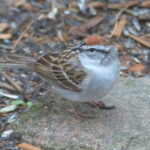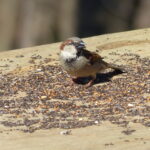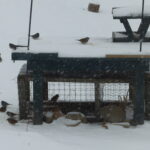Tree Sparrows. Two species. What could be more confusing? Well, there’s more. Both look like common House Sparrows (formerly known as English Sparrows.
Meet the American Tree Sparrows
Marion glanced at our feeders recently and noticed what looked like a Chipping Sparrow in the midst of a flock of House Sparrows. But it wasn’t. It was an AMERICAN TREE SPARROW. This bird nests in far northern Canada and is almost always spotted in winter. Why it doesn’t keep flying south and winter somewhere warmer than Iowa is a mystery to us. The bird does look like a Chipping Sparrow, but it’s bigger and “chippers” left long ago to winter where it’s warmer. We won’t see one again for a few months. So, a rusty capped sparrow in winter stands a good chance of being an AMERICAN TREE SPARROW.
Meet the New Tree Sparrows
Rich looked out the window a few days later and spotted an odd bird. It was near House Sparrows but looked slightly different. A dark spot on its cheek revealed it as a EURASIAN TREE SPARROW. What was it doing in our Iowa yard?
Back in 1870 a box of wild birds arrived in St. Louis from Germany. Inside were 12 Eurasian Tree Sparrows that were released. They slowly spread outward.
According to the Cornell University Laboratory of Ornithology’s ebird the bird spread north slowly and took about 150 years to reach our yard. It’s been widely spotted across the United States, but mostly along the Mississippi River.
Differences in Habitat Preferences
It looks like a House Sparrow at a quick glance. House Sparrows are at home in urban areas while the European Tree Swallow is more a denizen of brushy areas outside town. Sometimes they mingle. See a flock of House Sparrows. Take a close look. One may be a European Tree Sparrow.
European and American species share one trait. Both prefer feeding on the ground. Why they’re called tree sparrows beats us.
Learn More!
For accurate information on birds check out the Lab of Ornithology’s website.
- Chipping Sparrow
- House Sparrow
- Can you find the sparrows?





fascinating
We have numerous sparrows that visit our feeders daily. Sometimes I can make out the house sparrow. I know some of the sparrows, but it’s really confusing because some look so much alike.